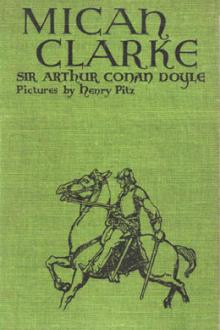Three Thousand Years of Mental Healing, George Barton Cutten [crime books to read TXT] 📗

- Author: George Barton Cutten
- Performer: -
Book online «Three Thousand Years of Mental Healing, George Barton Cutten [crime books to read TXT] 📗». Author George Barton Cutten
JOHN ALEXANDER DOWIE
Charles G. Finney (1792-1875) had at least one experience as a healer. During revival services at Antwerp, N. Y., in 1824, two insane women were cured, but Finney was directly concerned in the restoration of only one of them. Of this he gives an account in his memoirs. "There were two very striking cases of instantaneous recovery from insanity during this revival. As I went into meeting in the afternoon of one Sabbath, I saw several ladies sitting in a pew, with a woman dressed in black who seemed to be in great distress of mind; and they were partly holding her, and preventing her from going out. As I came in, one of the ladies came to me and told me she was an insane woman.... I said a few words to her; but she replied that she must go; that she could not hear any praying, or preaching, or singing; that hell was her portion, and she could not endure anything that made her think of heaven. I cautioned the ladies, privately, to keep her in her seat, if they could, without her disturbing the meeting. I then went into the pulpit and read a hymn. As soon as the singing began, she struggled hard to get out. But the ladies obstructed her passage; and kindly but persistently prevented her escape.... As I proceeded ... all at once she startled the congregation by uttering a loud shriek. She then cast herself almost from her seat, held her head very low, and I could see that she 'trembled very exceedingly.'... As I proceeded she began to look up again, and soon sat upright, with face wonderfully changed, indicating triumphant joy and peace.... She glorified God and rejoiced with amazing triumph. About two years after, I met with her, and found her still full of joy and peace."190
The so-called "Mountain Evangelist," George O. Barnes, who was born in 1827, added healing to his other revival efforts. After leaving the Presbyterian Church he did his work mostly in Kentucky as an independent minister, and there anointed with oil according to James 5:14 f. In his records little is said about the cures, but the daily number of anointings is given, amounting to at least five thousand in all. He believed that the devil, not God, sends sickness: God is the great healer. The anointing was simply a matter of faith. His formula varied and was very simple, as e. g., "Dear daughter, in Jesus's precious name I anoint thee with this oil of healing for thy maladies. Oh, go on thy way rejoicing. Be of good cheer. He is the great healer. He will make thee whole. He hath commanded it. Lean thy whole weight on Him."191 His views may be judged by the following extract from a sermon of his on "Our Healer": "Oh, the hospitals and drug-stores, the bitter doses, the pains and racks, the tortures—great God, may this people believe to-day that thou hast nothing to do with this, that all came in with sin, and the devil manages it all; and wherever we are afflicted God stands by wringing His hands, and saying, '...Return to me, O backsliding children. Come back to me, and I will keep the devil off of you.'"192 I take also some extracts from his daily record.
"July 19 [1881]. John and I took a long walk.... I shall not repeat the experiment, for I got many chiggers on me, which are tormenting me from head to foot while I write, I think because I trusted the pennyroyal to keep them off me instead of the Lord. It was not wilful, but a slip of forgetfulness, yet a door wide enough for Satan to enter a little bit. Now, instead of trying pennyroyal to get me rid of them, I will trust the Lord only.
"July 20. The chiggers gave exquisite torment. I shall never trust in pennyroyal again.
"July 21. Satan tried to get me wavering on the eye question, but the dear Lord set me up more firmly than ever.
"July 24. We have gotten into a little trouble by carelessly trying to help the dear Lord take care of his little organ. A key was silent, and yesterday Marie tried to remedy it. There was a good deal of taking out of keys, and dusting—result, two keys silent now, and one that won't be silent, but goes on in a bass wail through every song. So much for meddling with the dear Lord's work. We trust Him, when the lesson is learned, to set the little machine all right again.... The dear Lord cured the little organ this afternoon while we were at dinner; at least it was all right, as Marie with a happy smile informed me before she began to sing the first song. I gave thanks for it in the opening prayer, and then told the people all about it.
"July 27. Satan is not a little busy with me, injecting doubts as to the right to trust for eyes. Faith still quenches all his fiery darts, although it sorely tries me to be thus inactive in these long summer days, without reading my beautiful edition of Young's Concordance, useless at the bottom of my trunk. My Revised New Testament I can only get at through others."193
Leaving now the revivalists, let us take up the cases of others not revivalists who used anointing for healing. In her native hamlet of Maennedorf, Switzerland, Dorothea Trudel (1813-1862), the descendant of some generations of faith healers, cured many. Soon people began to come to her from near and far and, finally, at the solicitation of a "patient" of rank, she purchased a home where the afflicted could be near her. In 1856 the health authorities interfered. She was fined; an appeal was taken and, finally, she was permitted to carry on her work in connection with the home under some formal restrictions. During the course of the trial some authenticated cases of cure were produced: "one stiff knee, pronounced incurable by the best surgeons of France, Germany, and Switzerland; a leading physician testified to the recovery of a hopeless patient of his own; a burned foot, which was about to be amputated to prevent impending death, was healed without means. The evidence was incontrovertible, and the cases numerous. The cure was often contemporaneous with the confession of Christ by the unbelieving patient; but duration of the sickness varied with each case. Lunatics were commonly sent forth cured in a brief while." Nothing miraculous was claimed and no war was waged against physicians. It was not asserted that a cure was infallibly made, but it was pointed out as a simpler and more direct method. The means employed were gentleness, discipline, Bible reading, prayer, and anointing. After the death of Dorothea the home continued under the supervision of Mr. Samuel Zeller.
Charles Cullis (1833-1892), a young physician of Boston, suffered a crushing bereavement in the death of his wife shortly after their marriage, and then vowed to devote his life to charity. Inspired by Müller's Life of Trust he established a number of charitable institutions, relying on prayer and faith for their support. Some of these institutions were for the cure of the sick, and in connection with these, and otherwise, Dr. Cullis anointed and prayed with all who came to him. Every summer a camp-meeting was held at Old Orchard Beach, Maine, where the large collections gathered were the subject of annual comment. He was followed in his work by Rev. A. B. Simpson, of New York, who now conducts it. The latter was formerly a Presbyterian minister but is now an independent. He still heals and takes up collections. From the efforts of Cullis and Simpson have come the Christian and Missionary Alliance and other similar organizations with Pentecost as the text and apostolic gifts as the much-sought-after prize. The proof of success is found in healing, speaking with tongues, trances, visions, and other abnormal phenomena.
The "Holy Ghost and Us" movement, with headquarters at Shiloh, Maine, was an outgrowth of the Christian and Missionary Alliance propaganda. Rev. F. W. Sanford (1863- ) was born on Bowdoinham Ridge, Maine. He graduated at Bates College in 1886 and attended Cobb Divinity School for a short time. His ordination took place in 1887, after which he held two pastorates of three years each, presumedly in Free Baptist churches. In 1891, while attending meetings at Old Orchard, he was inspired to start "a movement on strictly apostolic lines, which was to sweep the entire globe." He started on this new work early in 1893 with Shiloh, Maine, as the centre. Relying on faith alone, several buildings were erected and paid for, among which is Bethesda—a Home of Healing: "For those who believe God told the truth when He said, 'The prayer of Faith shall save the sick.'" In an account of the healing we read: "We have seen ... in at least one case, the restoration of the dead to life." Quite a following embraced the doctrine at one time, but lately there has been a considerable decline.
An institution for faith healing was established in the north of London by Rev. W. E. Boardman (1810-1886). He called it "Bethshan" or the "Nursery of Faith" and refused to permit it to be called a hospital. The usual method of treatment was by anointing with oil and prayer, but it was claimed that many also were healed by correspondence. The results professed were very extravagant, among the cases being cancer, paralysis, advanced consumption, chronic rheumatism, and lameness of different kinds. As a proof of the cure of the last named affliction, numerous canes and crutches left behind by the healed were on exhibition.194
It is said that Lord Radstock practised healing through anointing in Australia about the same time.
There have been a number of prominent healers who have used prayer, and perhaps the laying on of hands, as the means for healing, and have usually eschewed anointing. Among these was Prince Hohenlohe (1794-1849). His was probably the greatest name in mental healing in the nineteenth century. He was born in Waldenburg and educated at several institutions. He was ordained priest in 1815 and officiated at Olmütz, Munich, and other places. In 1820 he met a peasant, Martin Michel, who had performed some wonderful cures, and in connection with him effected a so-called miraculous cure on a princess of Schwarzenberg who had been for some years a paralytic.195 From this experience he became enthusiastic in healing, and he acquired such a fame as a performer of miraculous cures that multitudes flocked from different countries to receive the benefit of his supposed supernatural gifts. In one year (1848-49) there were eighteen thousand people who obtained access to him. His name and his titles probably had not a little to do with his wide influence. They were Alexander Leopold Franz Emmerich, Prince of Hohenlohe-Waldenburg-Schillingsfürst, Archbishop and Grand Provost of Grosswardein, Hungary, and Abbot of St. Michael's at Gaborjan.
The testimony concerning his cures is from reliable witnesses. Notice the letter written by the ex-King of Bavaria to Count von Sinsheim, describing his own case:
My dear Count:
There are still miracles. The ten last days of the last month, the people of Würzburg might believe themselves in the times of the Apostles. The deaf heard, the blind saw, the lame freely walked, not by the aid of art, but by a few short prayers, and by the invocation of the name of Jesus.... On the evening of the 28th, the





Comments (0)